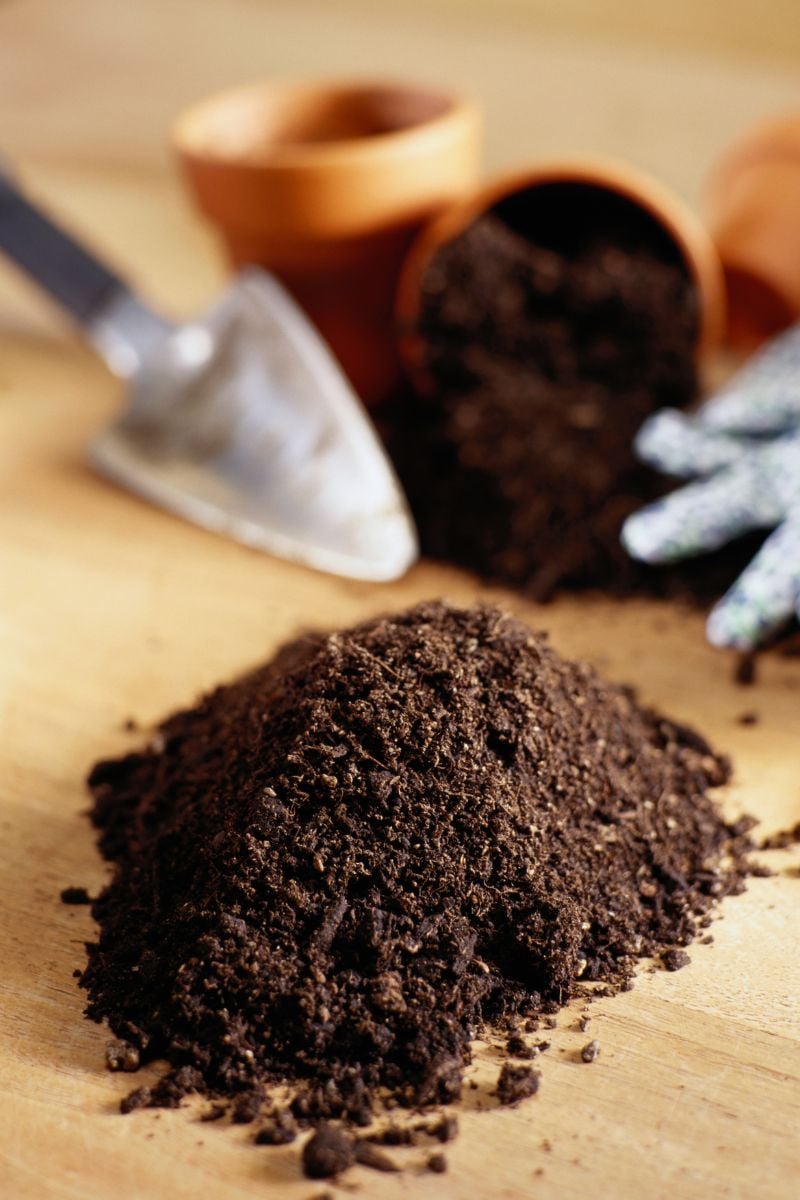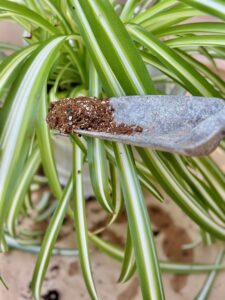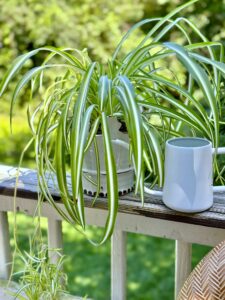Welcome back to part 3 of my Spider Plant Care series! In our first chat, we delved into the secrets of the perfect soil mix, and in our second round, we tackled the art of watering these popular houseplants. Now, let's kick back and chat about something equally important – repotting your Spider Plant (also known as a ribbon plant or airplane plant).
We'll explore when and why to repot, and how to spot the signs your green friend needs repotting. I'm here to walk you through the simple step-by-step process (with some helpful photos!) of giving your green companions a snug and comfy new residence. Get set to enjoy the art of repotting plants – it's all about good vibes and greener growth.

*This post includes affiliate links, for more info on affiliate links visit here
Jump to:
Why repotting is necessary
Repotting is a vital step in ensuring the health and robust growth of your spider plants. As these green companions flourish, their root systems outgrow their containers, leading to potential overcrowding and reduced nutrient absorption. Repotting provides much-needed space for roots to spread, access essential nutrients, and establish a solid foundation for continued vibrancy. It's a rejuvenating process that revitalizes your plant's well-being, contributing to lush foliage and a thriving spider plant that's sure to bring joy to any indoor space.

When to repot
Knowing when to repot your spider plant is a key aspect of successful plant care. As your green friend grows and thrives, it gradually outgrows its current home, and signs of this transition become apparent. By paying attention to certain cues and indicators, you can provide the right timing for repotting, ensuring your spider plant( also known as Chlorophytum Comosum) continues to flourish in a spacious and nurturing environment. Let's explore the telltale signs that it's time to give your mature spider plant a new, roomier pot to call home.
4 Signs that indicate it's time to repot:
- Root visibility - If you've noticed the once-contained tangle of roots starting to creep over the edge of your spider plant's pot and even poking out from the drainage holes, it's a clear sign that your green companion is in need of a new home. Root visibility indicates that your spider plant has outgrown its current container and is in search of more space to stretch its botanical legs. This is a natural part of its growth journey and a signal that it's time to provide a roomier environment for those eager roots to explore.
- Slow growth - A noticeable slowdown in growth can be a clear indicator that your once-thriving spider plant is craving a change of environment. Its leaves might not be reaching their usual lushness, and its overall appearance could be a bit lackluster. This stagnation often suggests that your spider plant has tapped out the available nutrients in its current potting mix.
- Frequent watering - Frequent watering can inadvertently become a signal that your spider plant is outgrowing its current pot. If you find yourself reaching for the watering can more often than usual and the potting mix seems to dry out unusually quickly, it might be time to consider repotting. As spider plants expand and develop, their root systems also grow, seeking out more space and nutrients. When the roots become densely packed, they can absorb water swiftly, leaving the soil dry sooner.
- Roots circling the pot - Observing roots circling the inside of the pot is a clear indication that your spider plant is in need of repotting. As these plants grow, their roots naturally extend and search for more space. When confined to a tight container, the roots can start circling around the inner edges, becoming root-bound. This constriction can impede the plant's overall growth and development.

Best time of year to repot
If your spider plant needs to be repotted, the best time of the year to do it is in the spring and summer months during its growing season. During the fall or winter, if possible it’s advisable to wait until the growing season to repot the plant.

Two ways to repot
Repotting a spider plant can be done through two effective methods. The first approach involves repotting the entire plant into a larger container. This method allows the plant to continue growing and flourishing in a more spacious environment.
Alternatively, the second method involves dividing the plant. Separate the plant into smaller sections, each with its own set of roots and leaves, and plant these sections in separate pots. This not only refreshes the original plant's growth but also offers the opportunity to propagate new spider plants.
Both techniques contribute to the plant's health and vitality, allowing it to thrive and brighten its surroundings. For more information on dividing spider plants, I encourage you to visit Gardening Know How's Dividing Spider Plants: When To Split A Spider Plant article.
Choosing the right pot and soil
Selecting an appropriate pot size and type for your spider plant
Choosing the right pot size and type for your spider plant is crucial for its continued well-being. As you prepare to repot, opt for a pot that is only slightly larger than the current one – giving your plant room to grow without overwhelming it. A pot with a diameter about 1-2 inches larger than the previous one is generally a safe bet.
Ensure the new pot has proper drainage holes at the bottom of the pot to prevent waterlogging, which can be detrimental to your plant's roots. Consider using a clay pot to help regulate moisture levels and prevent soil oversaturation for your spider plant, as the porous material allows for better drainage and aeration, promoting a healthier root system and overall plant growth.
The goal is to create a harmonious balance, providing your spider plant with enough space to flourish while maintaining a cozy environment that promotes healthy growth.

Importance of well-draining soil and its role in repotting
Well-draining soil is a superhero when it comes to repotting your spider plant. It's like giving your plant a breathable space to stretch its roots and thrive. When you repot, be sure to revisit my previous blog post on the best soil for spider plants, where we delved into the nitty-gritty of soil composition. Well-draining soil prevents water from pooling around the roots, minimizing the risk of root rot and other moisture-related issues. It promotes healthy aeration, ensuring your plant's roots get the oxygen they crave. So, as you embark on the repotting journey, remember that the right soil choice is the cornerstone of a happy and thriving spider plant.

How to Repot Spider Plants
Equipment
- 1 Pruning Shears or Scissors
- 1 Pair Gardening Gloves
- 1 Watering can
- 1 Trowel or Scoop
- 1 Newspaper or Kraft paper
- 1 Plastic Bag or Container To collect and dispose of old soil.
Materials
- 1 plant Spider Plant
- 1 piece Pot (1 size larger than current pot)
- 6 cups Fresh Potting Soil
Instructions
- Gather Necessary Supplies: Collect all the tools and materials you'll need for repotting, including a new pot, fresh soil, pruning shears, and gloves.

- Choose a Suitable Location: Select a well-lit and adequately ventilated area to work on repotting your spider plant. Make sure you have enough space to maneuver comfortably.

- Watering Before Repotting: Thoroughly water your spider plant a day or two before repotting. Adequate hydration will help minimize stress on the plant during the transplant process.

- Gently Removing from Current Pot: Carefully turn the plant's current pot upside down while supporting the base of the plant. Tap the bottom of the pot to loosen the plant and gently slide it out, avoiding damage to the leaves and stems.

- Evaluating the Root System: Examine the root ball to assess its health and size. Look for any signs of overcrowding, yellowing, or rotting roots.

- Pruning Damaged or Overcrowded Roots: With sterilized pruning shears, trim away any damaged, brown, or overcrowded roots. This encourages healthy growth in the new pot.

- Placing Fresh Soil: Add a layer of fresh, well-draining potting soil to the bottom of the new pot. The soil level should be such that the top of the root ball will sit just below the pot's rim.

- Positioning the Spider Plant: Set the spider plant in the center of the new pot, ensuring it sits at the correct height. Adjust the soil underneath, if necessary, to achieve the desired height.

- Adding More Soil: Gently fill in the gaps around the root ball with more potting soil, pressing it down lightly to eliminate air pockets. Leave some space at the top for watering.

- Watering the Newly Potted Plant: Thoroughly water the plant after repotting. Allow water to soak through until it drains from the bottom of the pot, ensuring proper hydration.

- Allowing the Plant to Settle: Place the newly potted spider plant in a location with indirect sunlight. Allow it to settle for a few days, monitoring for signs of stress or wilting.

- Adjusting Soil Level: If the soil settles significantly after the first watering, add more soil to the top of the pot as needed to maintain the appropriate level and support the plant.

Aftercare and maintenance
Now that you've given your spider plant a fresh start with a cozy new pot, it's time to master the art of post-repotting care. As your green friend settles into its new home, a little extra attention and tender loving care can go a long way in ensuring its continued growth and vitality. In this section, we'll delve into the important steps and tips for nurturing your recently repotted spider plant and helping it thrive.
Caring for your recently repotted spider plant:
- Adjusting watering frequency - Adjust your watering routine for your recently repotted spider plant. While it adapts to its new home, allow the top inch of soil to dry before watering. Avoid overwatering during this acclimation period. Gradually return to a regular watering schedule as the plant establishes itself.
- Monitoring for signs of stress - Keep a close watch for signs of stress in your recently repotted spider plant. Look for wilting, yellowing leaves, or a general decline in appearance. These indicators could suggest that the plant is adjusting to the new environment. Make sure to provide appropriate light, humidity, and water to aid its recovery.
- Providing indirect light and avoiding direct sunlight during the recovery period - During the recovery period, ensure your recently repotted spider plant receives indirect light. Shield it from direct sunlight, which can intensify stress. Place the plant in a well-lit area, but away from harsh rays. This gentle light exposure will aid in its adjustment and promote a healthier rebound.
Note: Right after repotting a plant, you might notice that there's very little visible growth. Just like us, plants need time to adjust to their new surroundings. During this initial period, most of their energy is focused beneath the soil as they acclimate. However, once this adjustment phase passes, you'll start to see new growth flourishing above the soil once again.

Common repotting mistakes to avoid
Repotting your spider plant can be a rewarding experience, but it's important to tread carefully to ensure your green companion continues to thrive. In the world of repotting, a little knowledge goes a long way, and steering clear of common mistakes can make all the difference in maintaining the health and beauty of your beloved plant. So, before you embark on your repotting journey, let's explore some pitfalls to watch out for, ensuring a smooth transition for your spider plant to its cozy new home.
Highlighting potential pitfalls and how to steer clear of them:
- Choosing a pot that's too large - Opting for a pot that's overly spacious might seem like a generous gesture, but for your spider plant, a bigger pot isn't always better. A pot that's too large can lead to excess moisture retention, potentially causing root rot and hampering the plant's overall growth. While your green friend may appreciate some room to stretch its legs, choosing a new container that provides a snug fit without cramping its roots is a wiser choice. This way, your spider plant can settle comfortably into its new space and continue to flourish. If you're unsure about the right pot size, refer to guidelines or seek advice to strike the perfect balance for your plant's well-being.
- Neglecting proper drainage - Neglecting proper drainage is a common pitfall that can quickly dampen your repotting success. Spider plants, like many houseplants, detest soggy roots. When you transfer your plant into a new pot without adequate drainage holes, excess water has no escape route, leading to waterlogged soil and potential root rot. It's essential to choose a pot with proper drainage to ensure that any excess water can easily flow out, preventing these moisture-related issues. Additionally, consider using well-draining nutritious soil, as mentioned in my previous blog post on spider plant soil, to further enhance drainage and create an ideal environment for your plant's growth.
- Not pruning or untangling roots - Skipping the crucial step of pruning or untangling roots during repotting can lead to some tangled troubles for your spider plant. Over time, as your plant grows, its roots can become bound and overcrowded, affecting its ability to absorb water and nutrients efficiently. When transferring to a new pot, it's essential to inspect the roots of the spider plant and trim any overly long or tangled roots. Gently untangling the roots before repotting allows them to spread out and establish themselves comfortably in their new home.
- Overwatering immediately after repotting - After you've given your spider plant a fresh start in a new pot, it's tempting to shower it with love and water. However, hitting the watering can too soon after repotting can actually drown your plant's enthusiasm for its cozy new home. Those roots need a chance to settle in and adjust to their new surroundings before they're ready to sip up more moisture. Overwatering right after repotting can lead to waterlogged soil, suffocating the roots and potentially causing root rot. Instead, exercise patience and give your spider plant a gentle and gradual reintroduction to watering.

Frequently asked questions
Spider plants generally benefit from repotting every 1-2 years, or when you notice the root ball has become overcrowded and the plant has outgrown its current pot. Younger plants may require repotting more frequently, while older plants with slower growth may need it less often.
It's best to avoid repotting a spider plant while it's flowering (white flowers) or has new growth (baby spider plants). Repotting can be stressful for the plant, and disrupting it during its flowering period may cause it to divert energy away from blooming. If possible, wait until after the flowering period to repot the mother plant.
If your spider plant shows signs of shock after repotting, such as wilting, drooping leaves, or a temporary halt in growth, don't be overly concerned. Give the plant time to recover by ensuring it's placed in a stable environment with appropriate indirect sunlight, temperature, and humidity. Maintain a consistent watering routine, allowing the top inch of soil to dry before watering again. Avoid fertilizing immediately after repotting.
Yes, your watering schedule may need adjustment once your spider plant is in its new pot. After repotting, the plant's root system may take some time to establish itself in the new soil, affecting its water uptake. It's important to closely monitor the moisture level of the soil. Allow the top inch of soil to dry out before watering, but avoid letting the plant become bone dry. Remember, overwatering can lead to root rot, so it's better to slightly underwater during the adjustment period. For more detailed tips on watering your spider plant, refer to "My Top 10 Quick Tips for Watering Spider Plants" for valuable insights on maintaining optimal moisture levels for your plant's well-being.
It's generally recommended to hold off on fertilizing your Spider plant immediately after repotting. Give the plant a couple of weeks to settle into its new environment and recover from the stress of repotting before introducing fertilizers. When it's time to fertilize be sure to visit my Indoor Plant Fertilizers You Can Make at Home (Feed Your Plants the Natural Way) post.

More spider plant care topics
- Find the perfect Spider plant potting mix that provides ideal drainage and nutrients for healthier, faster-growing spider plants
- Master essential spider plant watering techniques with ten quick tips to prevent both root rot and dehydration issues
Repotting your spider plant is a rewarding endeavor that promotes its health and vitality. By following the step-by-step guide provided, you can ensure a smooth and successful transition for your plant to its new home.
Remember to gather all necessary supplies, choose an appropriate location, handle the plant with care during removal, inspect and prune its roots, and provide a comfortable new pot with fresh soil. After repotting, closely monitor your spider plant for signs of stress, adjusting its watering and light conditions as needed. With proper care and patience, your spider plant will thrive in its rejuvenated space, gracing your living environment with its lush foliage and natural beauty.
Thank you for visiting the blog today for this How To Repot A Spider Plant: A Step-by-Step Guide for Healthy Growth post. For more plant ideas and plant care visit my indoor plants page.
Happy indoor gardening!




















